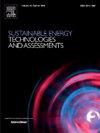FTO ligulate petals interconnected 3D- porous iron surface for enhanced interfacial interactions with exoelectrogenic bacteria
IF 7.1
2区 工程技术
Q1 ENERGY & FUELS
Sustainable Energy Technologies and Assessments
Pub Date : 2025-04-01
DOI:10.1016/j.seta.2025.104284
引用次数: 0
Abstract
Microbial fuel cells (MFCs) are a promising sustainable energy technology, with the bio-active anode playing a crucial role in their performance. The present study demonstrates a bio-active iron-based electrode that enhances bacterial adhesion and electron conductivity. The bacterial survivability on the electrode can enhanced by decorating its active porous framework with Fe2TiO5 (FTO) composite. These particles not only facilitate bacterial activity for electron transfer processes but also enhances the anode cell potential in the assembled double-chambered MFC. A superior specific surface area of 289.06 m2/g, satisfactory average surface roughness of 2.506 µm, and reduced charge transfer resistance of 12.89 × 100 Ω cm2 compared to 18.68 × 100 Ω cm2 for the Fe/0.2FTO and Fe electrodes were achieved. MFCs equipped with the Fe/0.2FTO anode yield a maximum power density of 1710.39 mW/m2 at a current density of 2.13 mA/m2, which is superior to that of Fe anodes. Anode biofilm morphology and surface texture demonstrated that the anode provides sufficient sites and mass transport pathways for exoelectrogenic bacterial species, promoting improved bacterial activity in mature biofilms. Thus, the FTO decorated porous 3D-framework anode with tunable surface properties, acts as a promising platform for sustained bacterial activity and stable operation of MFCs.

FTO舌状花瓣连接三维多孔铁表面,增强与外电细菌的界面相互作用
微生物燃料电池(MFCs)是一种很有前途的可持续能源技术,生物活性阳极对其性能起着至关重要的作用。本研究展示了一种生物活性铁基电极,可以增强细菌的粘附性和电子导电性。用Fe2TiO5 (FTO)复合材料修饰电极的活性多孔框架,可以提高细菌在电极上的生存能力。这些颗粒不仅促进了细菌在电子转移过程中的活性,而且提高了组装双室MFC的阳极电池电位。该电极的比表面积为289.06 m2/g,平均表面粗糙度为2.506µm,电荷转移电阻为12.89 × 100 Ω cm2,而Fe/0.2FTO和Fe电极的电荷转移电阻为18.68 × 100 Ω cm2。采用Fe/0.2FTO阳极的mfc在电流密度为2.13 mA/m2时的最大功率密度为1710.39 mW/m2,优于Fe阳极。阳极生物膜的形态和表面结构表明,阳极为产电细菌提供了足够的位点和质量运输途径,促进了成熟生物膜中细菌活性的提高。因此,FTO修饰的多孔3d框架阳极具有可调的表面特性,是维持细菌活性和mfc稳定运行的有希望的平台。
本文章由计算机程序翻译,如有差异,请以英文原文为准。
求助全文
约1分钟内获得全文
求助全文
来源期刊

Sustainable Energy Technologies and Assessments
Energy-Renewable Energy, Sustainability and the Environment
CiteScore
12.70
自引率
12.50%
发文量
1091
期刊介绍:
Encouraging a transition to a sustainable energy future is imperative for our world. Technologies that enable this shift in various sectors like transportation, heating, and power systems are of utmost importance. Sustainable Energy Technologies and Assessments welcomes papers focusing on a range of aspects and levels of technological advancements in energy generation and utilization. The aim is to reduce the negative environmental impact associated with energy production and consumption, spanning from laboratory experiments to real-world applications in the commercial sector.
 求助内容:
求助内容: 应助结果提醒方式:
应助结果提醒方式:


